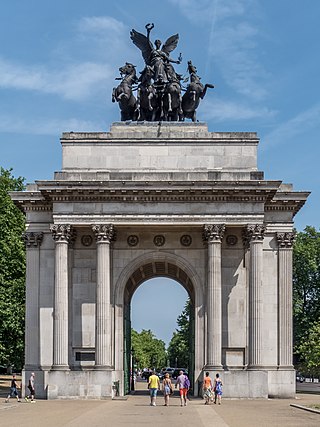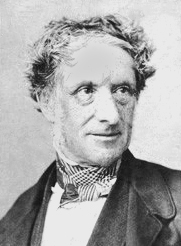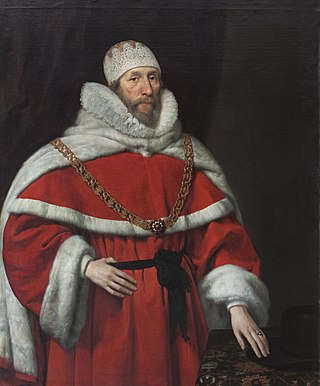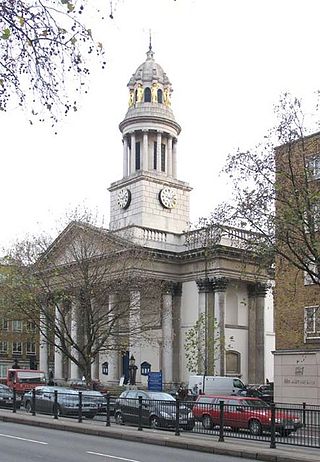
Great Cumberland Place is a street in the City of Westminster, part of Greater London, England. There is also a hotel bearing the same name on the street.

Great Cumberland Place is a street in the City of Westminster, part of Greater London, England. There is also a hotel bearing the same name on the street.
The street runs from Oxford Street at Marble Arch to George Street at Bryanston Square. [1]
It contains the Western Marble Arch Synagogue, near which stands a statue of Raoul Wallenberg.
Great Cumberland Place [2] is home to The Cumberland Hotel. [3]

The street was the home of Thomas Pinckney while he was the United States ambassador to the Court of St James's. [4]
Sir James Mackintosh lived in Great Cumberland Street, which was later re-numbered as part of Great Cumberland Place. [5]
The residents listed in 1833 were: "Hans Busk, Esq.; Sir Clifford Constable; Sir Frederick Hamilton; Lady C. Underwood; Sir G. Ivison Tapps; Baron Bülow (the Prussian Minister); General Sir R. M'Farlane; Leonard Currie, Esq.; Sir S. B. Fludyer, Bart.; Lady Trollope; Earl of Leitrim; Sir Alexander Johnston; and the Hon. and Right Rev. the Lord Bishop of Norwich", and in Great Cumberland Street "Lord Saltoun; Mrs. Portman; John Wells, Esq.; Colonel Sherwood; Captain Richard Manby; John Lodge, Esq.; Major Murray; Robert Cutlar Fergusson, Esq.; John N. McLeod, Esq.; and Lord Bagot". [6]
The explorers James Theodore Bent and Mabel Bent lived first at Number 43 and then Number 13 Great Cumberland Place from the early 1880s until Mabel Bent's death in 1929. [7]
The arts consultant and administrator Adrian Ward-Jackson lived in a one-bedroom flat at No. 37 in the 1980s. [8]

The West End of London is a district of Central London, London, England, west of the City of London and north of the River Thames, in which many of the city's major tourist attractions, shops, businesses, government buildings and entertainment venues, including West End theatres, are concentrated.

Edward Hodges Baily was a prolific British sculptor responsible for numerous public monuments, portrait busts, statues and exhibition pieces as well as works in silver. He carved friezes for both the Marble Arch and Buckingham Palace in London. His numerous statues of public figures include that of Horatio Nelson on top of Nelson's Column and Charles Grey, 2nd Earl Grey on Grey's Monument in Newcastle upon Tyne. Throughout his career Baily was responsible for creating a number of monuments and memorials for British churches and cathedrals, including several in St Paul's Cathedral.

The Marble Arch is a 19th-century white marble-faced triumphal arch in London, England. The structure was designed by John Nash in 1827 as the state entrance to the cour d'honneur of Buckingham Palace; it stood near the site of what is today the three-bayed, central projection of the palace containing the well-known balcony. In 1851, on the initiative of architect and urban planner Decimus Burton, a one-time pupil of John Nash, the arch was relocated to its current site, near the northeast corner of Hyde Park, so that expansion of Buckingham Palace could proceed.

Hyde Park Corner is between Knightsbridge, Belgravia and Mayfair in London, England. It primarily refers to a major road junction at the southeastern corner of Hyde Park, that was originally planned by architect Decimus Burton. The junction includes a broad green-space roundabout in its centre, which is now the setting for Burton's triumphal Wellington Arch.

The Wellington Arch, also known as the Constitution Arch or (originally) as the Green Park Arch, is a Grade I-listed triumphal arch by Decimus Burton that forms a centrepiece of Hyde Park Corner in central London, between the corner where Hyde Park meets Green Park. The Arch stands on a large green-space traffic island with crossings for pedestrian access. From its construction (1826–1830) the arch stood in a nearby location, slightly to the east, directly across from Burton's Ionic screen entrance to Hyde Park; it was moved a short distance to its current site at the top of the Constitution Hill road in 1882–1883. The triumphal arch originally supported a colossal equestrian statue of the 1st Duke of Wellington by the sculptor Matthew Cotes Wyatt, acquiring its name as a result. Peace descending on the Quadriga of War by sculptor Adrian Jones, a bronze of the Goddess of Victory Nike riding a quadriga, has surmounted the arch since 1912.

Great Marlborough Street is a thoroughfare in Soho, Central London. It runs east of Regent Street past Carnaby Street towards Noel Street.

Sir Richard Westmacott was a British sculptor.

The Western Marble Arch Synagogue is a Jewish place of worship in central London. It is the result of a merger between the Western and the Marble Arch Synagogues in 1991, with the former congregation dating back to 1761. The current building is in Great Cumberland Place, Westminster. It is a leading Orthodox Judaism synagogue and offers religious and social activities to its members and the wider community.

Sir Henry Hobart, 1st Baronet, of Blickling Hall, was an English politician who succeeded Sir Edward Coke to become Chief Justice of the Court of Common Pleas.

St Marylebone Parish Church is an Anglican church on the Marylebone Road in London. It was built to the designs of Thomas Hardwick in 1813–17. The present site is the third used by the parish for its church. The first was further south, near Oxford Street. The church there was demolished in 1400 and a new one erected further north. This was completely rebuilt in 1740–42, and converted into a chapel-of-ease when Hardwick's church was constructed. The Marylebone area takes its name from the church. Located behind the church is St Marylebone School, a Church of England school for girls.

Bryanston Square is an 800-by-200-foot garden square in Marylebone, London. Terraced buildings surround it — often merged, converted or sub-divided, some of which remain residential. The southern end has the William Pitt Byrne memorial fountain. Next to both ends are cycle parking spaces.

Sir Francis Gawdy was an English judge. He was a Justice of the King's Bench, and Chief Justice of the Common Pleas. His country seat and estates were in Norfolk.
Sir James Altham, of Oxhey, Hertfordshire, was an English judge, briefly a member of the Parliament of England, and a Baron of the Exchequer. A friend of Lord Chancellor Francis Bacon, Altham opposed Edward Coke but advanced the laws of equity behind the fastness of the Exchequer courts, so long considered almost inferior. Through advanced Jacobean royalism he helped to prosecute the King's enemies and centralise royal power of taxation. With Sir Edward Bromley, he presided at the Lancashire witch trials in 1612.

Sir Stephen Soame was an English merchant, landowner and politician who sat in the House of Commons in 1601. He served as Lord Mayor of London for the year 1598 to 1599.
Sir Thomas Parr was an English landowner and elected Member of Parliament six times between 1435 and 1459. He was great-grandfather of Queen Catherine Parr, the sixth wife of King Henry VIII.

Sir Robert Brooke was an English landowner, magistrate, commissioner, administrator and MP who sat in the House of Commons between 1624 and 1629. He made his country seat at Cockfield Hall, Yoxford, Suffolk.
Sir Matthew Browne of Betchworth Castle, Surrey, MP, was the only son of Sir Thomas Browne and Mabel Fitzwilliam. He was involved in legal and financial transactions concerning the Globe Theatre in 1601. He was killed in a duel with his kinsman, Sir John Townshend, on 1 August 1603.

A monument to Raoul Wallenberg stands at Great Cumberland Place in London's Marble Arch district, outside the Western Marble Arch Synagogue and near the Swedish Embassy. The 10 ft bronze monument was sculpted by Philip Jackson and is a larger-than-life representation of Wallenberg, standing against a bronze wall made up of 100,000 Schutzpässe, the protective passes used by Wallenberg to rescue Hungarian Jews.

Mount Street is an east–west, quite narrow, archetypal street in the Mayfair district of the City of Westminster, London fronted by many mid-rise buildings, mostly of a narrow frontage. The sides of two very grand hotels flank part of either end of the street. Small, high-end property businesses, investment funds and accountancy businesses punctuate the buildings as well as a row of traditional businesses and conversion-style mansion block apartments or, more generally, authentic such homes.

Sir Frederick Fletcher-Vane, 2nd Baronet, was a British politician, landowner and aristocrat. He was MP for the pocket borough of Winchelsea, between 1792 and 1794, the borough of Carlisle, between 1796 and 1802, and again for Winchelsea, between 1806 and 1807. Sir Frederick was the 2nd Baronet of Hutton and a descendant of Sir Henry Vane the Elder. In 1788 he served as High Sheriff of Cumberland.